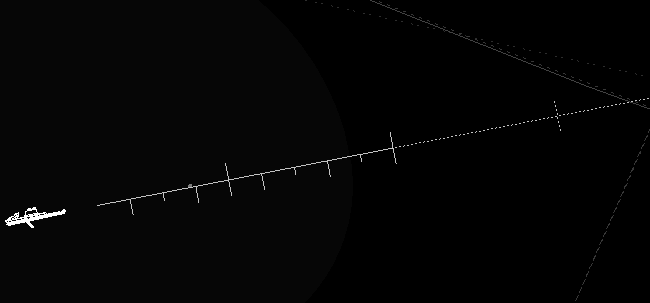This is an old revision of the document!
radial element
| Element | radial | |
|---|---|---|
| Attribute | Format | Remarks |
| trk | integer | inbound track value (0-360) |
| rad | integer | outbound radial value (0-360) |
| len | float | length of radial to draw (in nautical miles) |
| offset | float | offset distance in nm - start radial line from point this point |
| stipple | integer | stipple line bitwise pattern definition |
| width | float | line width |
| color | string | color id name |
| r | byte | color RGB value (0-255) |
| g | byte | color RGB value (0-255) |
| b | byte | color RGB value (0-255) |
The <radial> element can contain one or more <marker> sub elements:
| Element | marker | |
|---|---|---|
| Attribute | Format | Remarks |
| int | integer | interval value at which to draw this marker |
| offset_cw | float | length in nautical miles of the marker to draw on the clock wise side |
| offset_ccw | float | length in nautical miles of the marker to draw on the counter clock wise side |
| skip | integer | skip x markers before starting to draw first marker |
| number | integer | draw only x number of markers |
| stipple | integer | stipple line bitwise pattern definition |
| width | float | line width |
| color | string | color id name |
| r | byte | color RGB value (0-255) |
| g | byte | color RGB value (0-255) |
| b | byte | color RGB value (0-255) |
Each radial requires 1 <point> element which corresponds to the start of the radial. The <marker> elements are optional.
Use a radial element to draw ILS runway extension lines
example
<!-- ILS EBOS RWY 26 -->
<radial trk="259" len="20"color="ILS">
<point lat="N0511147872" lon="E0025109331"/>
<marker int="1" offset_cw="0.5" offset_ccw="0.5"/>
<marker int="5" offset_cw="1.0" offset_ccw="1.0"/>
<marker int="10" offset_cw="1.0" offset_ccw="1.0"/>
</radial>
<!-- ILS EBOS RWY 08 -->
<radial trk="079" len="10" color="ILS">
<point lat="N0511211970" lon="E0025349610"/>
<marker int="1" offset_cw="0.5" offset_ccw="0"/>
<marker int="5" offset_cw="1.0" offset_ccw="0"/>
</radial>
example using offset, skip and number attributes …
Smart usage of the <radial> element combined with several <marker> elements can result in complex radial drawings such as runway extension lines with different markers depending on the distance from the threshold:
<!-- runway extension line, stippled, 25 NM long -->
<radial rad="079" len="25" width="1" offset="10" stipple="52428" color="ils">
<!-- starting point -->
<point lat="N0511211970" lon="E0025349610"/>
<!-- draw 2 markers every 5 NM, skip first 3, counterclockwise 0.5 NM long, clockwise 0.5 NM long -->
<marker int="5" offset_ccw="0.5" offset_cw="0.5" skip="3" number="2"/>
</radial>
<!-- rwy extension line, 10 NM long, drawn on top of the first 10 NM of the previous stipple line -->
<radial rad="079" len="10" width="1" offset="1" color="ils">
<!-- starting point = equal to the starting point of the previous stipple line -->
<point lat="N0511211970" lon="E0025349610"/>
<!-- draw a marker every NM but skip first 2, only clockwise 0.25 NM long -->
<marker int="1" offset_ccw="0" offset_cw="0.25" skip="2"/>
<!-- draw a marker every 2 NM but skip the first one, clockwise 0.5 NM long -->
<marker int="2" offset_ccw="0" offset_cw="0.5" skip="1"/>
<!-- draw a marker every 5 NM but skip the first one, clockwise and counterclockwise 0.5 NM long -->
<marker int="5" offset_ccw="0.5" offset_cw="0.5" skip="1"/>
</radial>
The radial line starts with an offset of 1nm from the runway threshold, the first two 1nm markers are skipped, and the first 2nm and 5nm markers are also skipped.
